| 1 | Africa’s longest venomous snake |
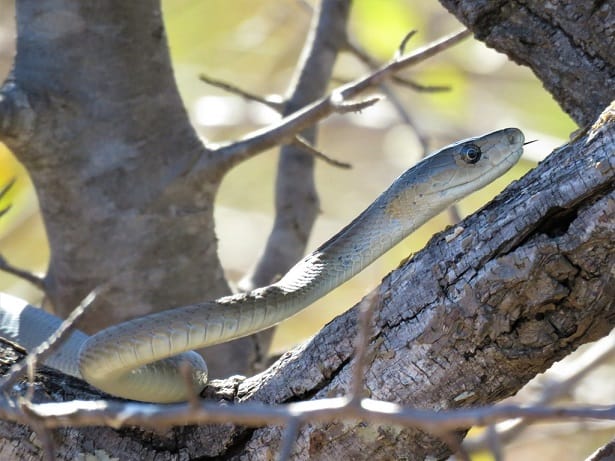
The black mamba is a species which needs no introduction. You know they’re aggressive, you know they’re deadly, and you know that they’re extremely difficult to outrun once they’ve decided to kill you.
The black mamba (Dendroaspis polylepis) has probably done more to decrease tourism in Africa than any other animal. A hippo, you can watch comfortably from your safari vehicle. Crocodiles tend to rest calmly on river shores, and are mostly a danger to fishing boats. But black mambas could be rustling through any bush, through any wispy piece of undergrowth. There’s no animal in Africa which generates a higher fear quotient.
Black mambas are fairly widespread in Africa, with the highest numbers appearing in southern nations. You’ll find them in eastern South Africa, Zambia, Botswana, Zimbabwe, and Mozambique. Further north, they appear in Kenya, Tanzania and Rwanda. Countries they don’t appear in include Nigeria, Togo, Benin, Niger and Ghana.
The black mamba’s venom completely lives up the horrendous reputation surrounding it. The first symptoms begin within 10 minutes, and death within 20 minutes isn’t exceptional. Black mamba venom is heavily neurotoxic, and leaves almost no local symptoms like peeling skin or blackening necrosis. Instead, the symptoms begin with drooping eyelids, a metallic taste, blurred vision and involuntary muscle twitches.
The is only the first wave, and the second is a tsunami, leaving the victim unconscious, paralysed, and ultimately dead via respiratory failure. Other symptoms include nausea and diarrhoea. Black mambas have an extremely high venom yield of up to 400mg, but just two drops can kill a human being. Sometimes, squirts of the generous venom yield will fly everywhere as they bite.
| 2 | Nervous and energetic |
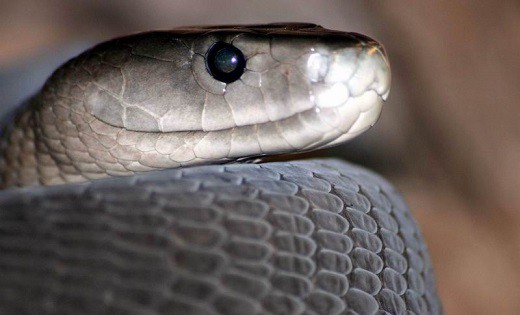
The black mamba is a skittish and nervous snake. They often bobble their head from side to side anxiously, and have an infamous ability to raise their upper bodies an entire metre off the ground to scout ahead. Black mambas dislike human presence so strongly that they’ll flee when an intruder is 40 metres away.
African locals believe that the black mamba is so bloodthirsty that it actually plans attacks on humans, then cold-bloodedly executes them. It’s actually a shy snake which prefers to slither away to safety. Nevertheless, if you stand between a black mamba and its lair (which is a permanent year-round hidey hole), there’ll be hell to pay. You could be blocking its route on a footpath; you wouldn’t know you were doing anything wrong.
An aggressive black mamba performs its infamous body raise, and opens its black mouth wide. They’ll fleck their tongue and hiss loudly, and reveal their 0.75cm long fangs. Legend has it that they can balance on the tip of their tail, raising their entire 2.5 metre body up.
| 3 | The fastest snake worldwide? |

In South Africa, it’s common knowledge that an enraged black mamba can slither as fast as a galloping horse, or even a car. A horse can run at 35-40mph, while a black mamba maxes out at 12.5mph. Nevertheless, this still makes them one of the fastest snakes on Earth, piling extra horror onto their corrosive venom. The average human running for their life can reach 12mph, while the average male jogger moves at 8mph.
It’s true that if the black mamba has the eye of the assassin on you, it’s very difficult to get away. Most disturbingly, it can travel at those high speeds with its upper body still raised up, watching you determinedly. When a black mamba strikes, it does so rapidly, with multiple lunges in rapid succession. They hate one thing most of all: sudden movements. Herpetologist Jack Seale managed to sleep calmly in an entire room full of black mambas and not get bitten.
Compared to its relative the green mamba, Dendroaspis polylepis is mostly a ground snake. However, they sometimes climb trees, and slither up them extremely quickly.
| 4 | May reach 4.5 metres |
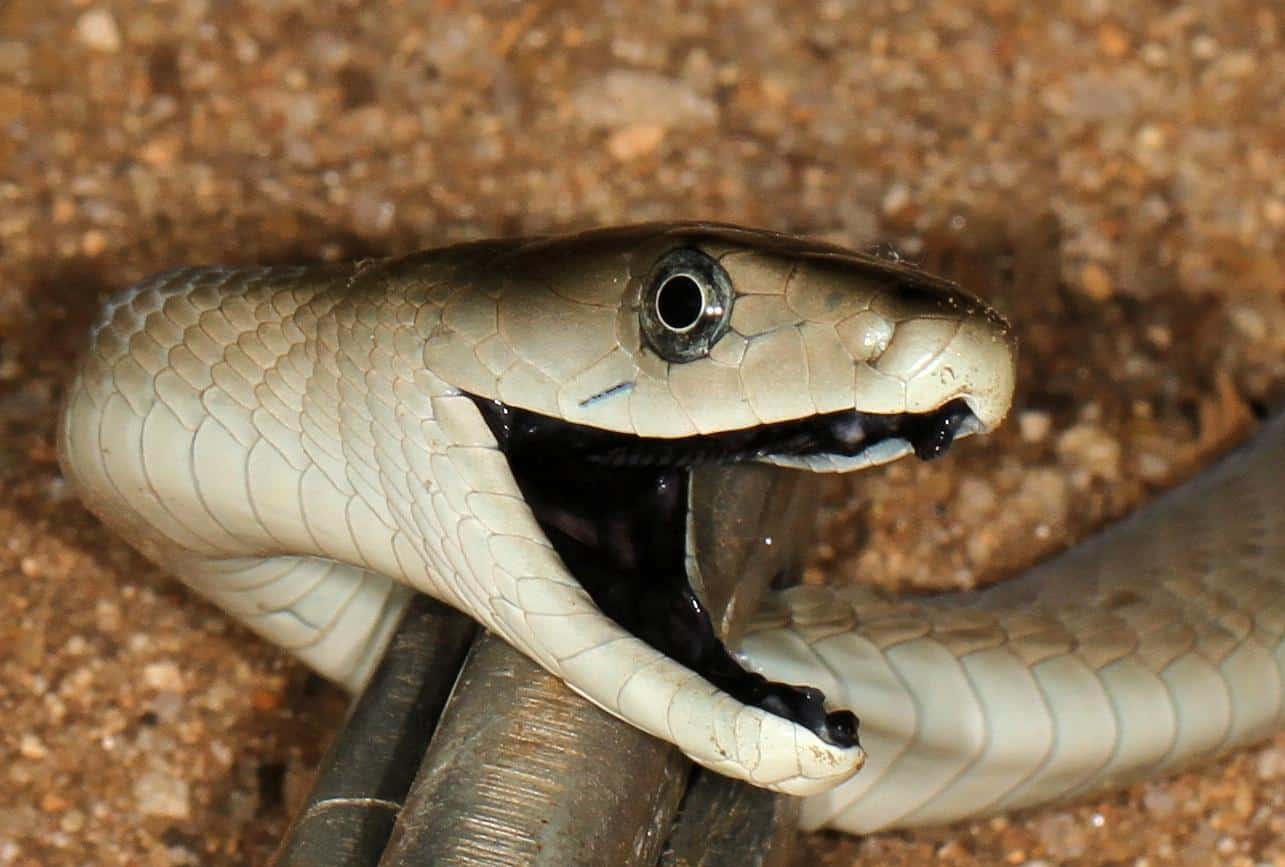
One theory is that the black mamba’s name was originally the black-mouthed mamba, which became shortened over time. Its body isn’t particularly black, more grey-white with black cracks visible between scales. However, its mouth and tongue are very dark, as villagers notice when it bares its fangs at them. Their irises can be black as well, with round pupils, while the pupil is often surrounded by a silvery ring. Their bellies are grey-white, while young black mambas can begin life as an olive-green. Another theory is that as the tree-dwelling green mamba already had its name, it made sense to call its cousin the black mamba.
The black mamba is the second longest venomous snake in the world, after the king cobra. Tales of 6 metre black mambas spanning dirt tracks were common, and tales of 4.5 metre monsters could easily be true. 2-2.5 metres is the norm, and 3 metres isn’t exceptional at all.
One of the longest officially documented black mambas of the last 30 years measured 3.8 metres. The book Snakes of Southern Africa states that black mambas may reach 4.3 metres “in exceptional cases”. Some believe that black mambas were that massive once, but have shrunk as the giant ones have been killed, similarly to over-poached elephants. Either way, a black mamba’s tail can exceed the entire body of an American lined snake, as its tail is particularly long, and can make up 25% of total length. The black mamba isn’t long yet bulky like an African rock python; it’s thin and nimble.
| 5 | Stays in one lair for months |
Black mambas can tread in many habitats, but they have a preference towards drier spots. You can find this slithery speed demon in savannah, woodlands, rocky slops and occasionally dense forests. They need at least some trees, whether real forests or scattered clumps, as the downed logs provide shelter.
In Swaziland, black mambas are notorious for invading sugar plantations. Over 50% of Swaziland’s workforce operates in agriculture, and the black mamba likes to climb the sugar stalks and bask on the sunlight above, while waiting for prey to pass. The workers often discover this to their demise.
One of a black mamba’s cosier tendencies is to return to a permanent lair all year round. This can be anywhere, including overgrown ornamental gardens, roofs of houses where they wait for bats, or women’s toilets in a caravan park. When researchers found the toilet base, it was covered with shed skins, like the mamba had been there for months. Black mambas operate by day, and return to their base to rest at night.
| 6 | Diet: 80% mammals |
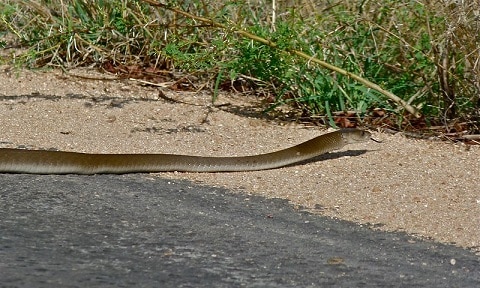
Another horrifying feature of the black mamba is powerful, corrosive acid. Fortunately, this isn’t spat from its mouth, but inside its stomach, allowing it to digest prey in just 8-10 hours. The black mamba’s diet mainly consists of mammals, with a side helping of birds. In captivity, they completely reject snakes, amphibians and lizards offered to them.
A study from eastern Transvaal and Namibia found a diet of 81.48% mammals, and 14.81% birds. Their green mamba relative was skewed further towards birds, at over 40% of meals. Black mambas ate a wide variety of mammals, including…
-Lesser bushbaby (Galago senegalensis).
-Red veld rat (Aethomys chrysophilus).
-Dwarf mongoose (Helogale parvula).
-Tree squirrel (Paraxerus cepapi).
-Namaqua rock rat (Aethomys namaquensis).
Black mambas bite their prey, and wait for paralysis and death to be complete before swallowing them. For such a long snake, black mambas prefer much smaller prey, with an average of just 4.72% of their body weight. An exception to this is their taste for the dassie, or rock hyrax. This cuddly mammal has been used as a South African folk medicine for decades, and some tribal names for black mamba even translate to “dassie hunter”.
| 7 | Seale’s lucky escape |
Jack Seale was the brave herpetologist who slept in a room full of slithering black mambas and lived to tell the tale. Another day, he wasn’t so lucky. Seale lived in South Africa, and was carefully transporting a black mamba into a cage, when an assistant bumped into him. The distracted Seale loosened his grip for just a moment, and this gave the black mamba the opening to savagely bite his ankle. Venom squirted everywhere, and Seale knew he had just minutes to live. He instantly grabbed some adrenaline and antivenom, and injected himself with copious quantities. Minutes later, the black mamba venom had dispersed to every corner of his body. Seale faded away into the oblivion of unconsciousness.
When he awoke, he found himself a prisoner – in his own mind. Seale had consciousness, but was unable to move even his lips. He was in a coma, in a hospital bed with beeping machinery, strapped to a life support machine. He was fully paralysed, but able to hear everything happening around him. He was able to hear the doctors’ discussions, including how the black mamba venom had destroyed his brain tissue, leaving him a likely vegetable if he ever woke up. Seale, of course, knew differently.
Seale’s wife marched over and insisted they keep him alive, and for 8 days Seale lay there, unable to communicate. Then, summoning up all his effort, he finally managed to twitch a finger. The doctors weren’t impressed, but when he moved the finger in clear response to their questioning, a miracle seemed at work. Weeks later, Jack Seale walked out of hospital with no permanent injuries, and continued his profession. This is what black mamba does – it’s one of the most powerful paralysis agents in the snake kingdom.
| 8 | Crazy African folklore |
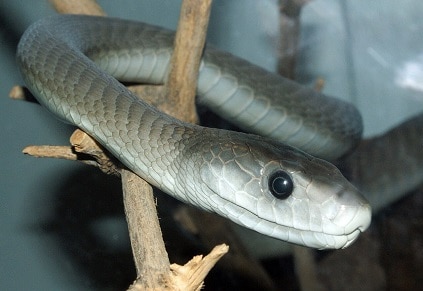
Another crazy (though never disproven) rural legend is that the black mamba will bite its tail to form a hoop, and roll down a hill at top speeds. At the bottom, it will then unwind and propel itself at the victim like a thunderbolt. Black mambas are also rumoured to hang from trees, wait for cows to enter a kraal, and cold-bloodedly kill 5 of them. A Tanzanian name translates to “grass cutter”, in the belief that they cut grass.
A feared sight is a black mamba crossing a road. Why? Because this forces the car to stop, allowing the black mamba to coil itself in a circle within the car wheel. As the relieved occupants drive off, little do they know that a murderous passenger will travel the next 40 miles with them.
A Zulu legend speaks of the Ndlondlo, the most terrible snake in the world. Ndlondlo is a gigantic black mamba with feathers in its head, which cries in the bushes and murders anyone who stops to investigate. It strikes like lightning, so quick that the feathers make a whistling sound in mid-air. Nobody has ever captured Ndlondlo on film, yet nobody has ever disproved its existence. The belief is widespread in Zulu villages. Some believe the legend originated from King Shaka and his warriors, who wore feather caps.
| 9 | Peaceful with other snakes |
Despite the rage, aggression and legendary murderousness, the black mamba is extremely relaxed about other snakes nearby, even happy to see them. They mainly interact with other black mambas when mating, which happens in early spring. Females lay 6-17 eggs, and abandon them instantly, and the newborns are venomous from day one. Males will sometimes wrestle for mating rights, raising their bodies 1 metre in the air.
However, scientists investigating a black mamba’s permanent lairs have found that two will sometimes share them, even lying intertwined for warmth. Even more weirdly, one black mamba became best friends with a Mozambique spitting cobra. The two would lie together most days, and were often seen entering the lair together. This was particularly weird given that black mambas are diurnal whereas Mozambique spitting cobras are nocturnal. The two always made time for each other. The two snakes lived alongside each other for 11 months of harmony, in the same base.
The Mozambique spitting cobra then disappeared for 2 months, but returned, and remained until the end of the study. Not once did they try to attack each other. In a lair in Nshongweni, South Africa, a rock python entered a black mamba lair and stayed for a week. The black mamba only reacted by raising its head.
| 10 | Nemesis: mongoose |
The black mamba has several enemies in the sweeping African savannah. They’ve been found in the stomachs of bass, and Nile crocodiles. They sometimes flee at the mere sight of these hungry relics from the prehistoric past. However, their true nemesis, which inspires real fear in their bones, is the mongoose.
This snake-hunting mammal has mutations in the acetylcholine receptors of muscles, which the black mamba’s neurotoxins normally bind to. Like a wonky jigsaw puzzle, the toxins will no longer fit and exert their paralysing effects. Consequently, the mongoose can hunt and eat black mambas without fear, and their nimble, incredibly fast reactions add to the melee. If a black mamba sees a mongoose coming, it can either flee, or fight, in which case it will probably lose.
The black mamba duels with its body raised 1 metre in the air, weaving in and out. The mongoose duels like it’s on fast forward, with three cups of caffeine poured into the video player. The fights often last 1 minute, but can end in a millisecond, with the mongoose lunging forward and breaking the mamba’s neck with a single bite (see this video). No animal on Earth is better at hunting black mambas than the mongoose. Another black mamba nemesis is the honey badger, with similar muscle cell mutations.
